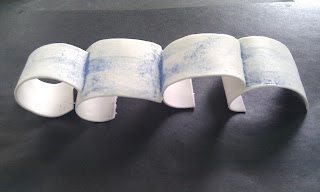In the meantime I started to work with fiber-clay made of the casting slip- and this one is even stronger and looks more promising :)
First I have prepared the porcelain casting slip which wasn't that hard as I thought it will be.
There are just few simply steps to do it:
1. Get a bucket (big one) and put 2l of water
2. Dissolve 26g of dispect in 600ml of HOT water then add to the bucket
3. Cut porcelain in small pieces and put them into the water so they are well covered
4. When you have about 1/4 of a porcelain bag already in the bucket start mixing everything with the big blender :)
5. Add more porcelain to the mixture slowly until it will become nice and smooth.
I have mixed the casting slip with nylon fiber ( 1l+ 20g) and then dried it on the plaster bat.
I have noticed that making cylinders works well with my fiber-castingporcelain.
I am getting excited again. :)















Hi Aga. I'm a MA student at BathSpa Uni. I just googled adding fibre to casting slip and your post came up. Thanks. I slip cast ultra-thin porcelain forms that I combine with light. As the forms get bigger, they become impossible to handle before firing, so I thought I might try adding fibre for extra green strength. Sounds like you have positive experience with this. Thanks. Helen PS: Love your work! www.helenmorken.no
ReplyDeleteHi Helen :)
ReplyDeleteThank you for your interest in my blog :)
When I was using fiber and casting slip I was hand building... I didn't cast with it and I think I would be quite difficult as the mixture is thick and can be lumpy... I was using plaster batts to dry the clay a bit and them form it the way I liked. As far as I remember while drying the fiber can stick to the plaster... But it is worth trying :) Work with different thicknesses as well to find the one that will work with your form :) It is very exciting and nice material to work with and still translucent which is great when you work with light :)
Another Tip I can give you is: brush some talc powder on your plaster before putting the clay on it - that will help with releasing the 'cast' BUT talc will act as a glaze - giving nice shine which can be controlled by the amount of talc. It is good if you want just clear shiny finish but if you will apply a glaze over it talc will act as opacifier and can ruin your piece - so test it!
If you need any more help let me know :) Maybe I can help you :)
To make sheets of fiber clay spread the mixture on plaster using a plastic card (old credit one or sth simmilar) and keep adding until you'll get the thickness you want. You can reshape the sheets when they dry a bit and use the mixture to join the pieces (as you would with with slurry and normal slabs). You have to use scissors to cut it as the blade won't give you a clear edge.
You can also rewet the sheets if you want to put them into moulds (like bowls) but be careful as too much water will weaken the body and it will crack.
That's all I can think of now but as I said let me know if you have more questions.
Good luck :)
Thanks Aga. I'll try and let you know how I get on.
ReplyDelete